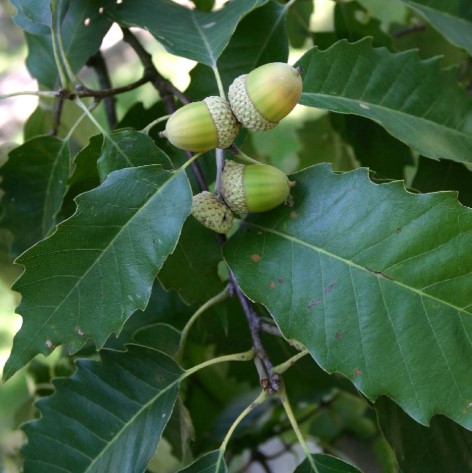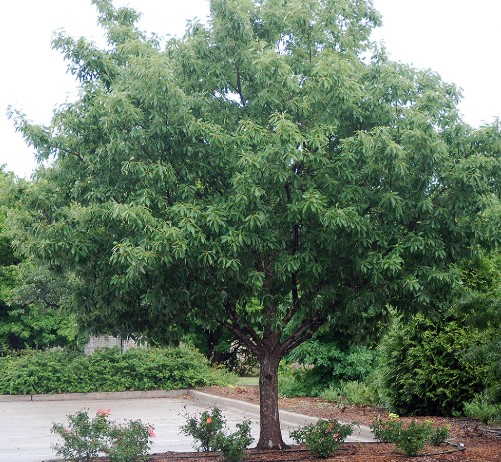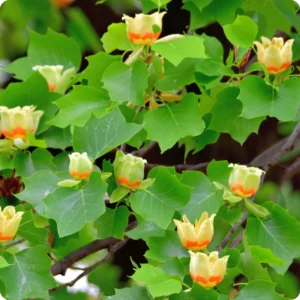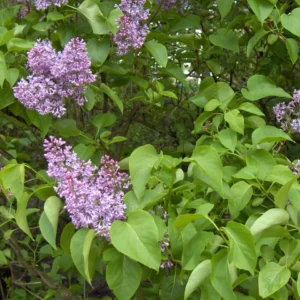Description
Chinquapin Oak (Quercus muehlenbergii) 1 Yr Old Seedling
Overview
The Chinquapin Oak (Quercus muehlenbergii) is a versatile, medium-sized oak tree native to North America, known for its distinctive leaves and valuable acorns. This tree thrives in a variety of soil types, including well-drained, rocky soils, and is highly drought-tolerant once established. The Chinquapin Oak’s resilience, combined with its fast growth and striking autumn color, makes it an excellent choice for landscaping, reforestation, and wildlife habitats.
Chinquapin Oak Native Range
Native to the central and eastern United States, the Chinquapin Oak is commonly found in dry, rocky slopes and upland forests.
Growth and Form
- Height: Grows 18–24 inches per year, reaching 40–50 feet at maturity.
- Spread: The canopy spread at maturity is 30–40 feet.
- Growth Rate: Moderate to fast, making it an excellent choice for those looking for a resilient oak with a manageable size.
- Foliage: Deeply lobed, glossy dark green leaves that turn yellow to orange in the fall.
- Bark: Light gray, smooth bark that matures into a more textured, ridged surface with age.
Ecological Benefits
- Wildlife Habitat: The Chinquapin Oak produces acorns that provide a food source for squirrels, deer, and birds.
- Soil Health: Fallen leaves decompose quickly, adding organic material to the soil and enriching surrounding plant life.
- Erosion Control: The tree’s deep root system helps prevent soil erosion, making it a great choice for upland or hilly areas.
Chinquapin Oak Hardiness and Climate Tolerance
- Hardiness Zones: 4–8, adaptable to a variety of climates.
- Cold Tolerance: Hardy down to -20°F (-29°C), making it suitable for colder regions.
- Drought Tolerance: Highly drought-tolerant once established, making it ideal for areas with dry conditions.
- Soil Preferences: Prefers well-drained soils, including sandy and rocky soils, but can adapt to loam and clay soils as well.
Planting and Care
- Planting Location: Thrives in full sun but can tolerate some light shade. Ensure it has enough space to grow to its full size.
- Watering: Requires regular watering in the first few years to establish strong roots. Once established, the tree needs minimal watering.
- Fertilization: Fertilize with a slow-release, balanced fertilizer in early spring to promote healthy growth.
- Pruning: Minimal pruning required. Trim any dead or damaged branches in late winter or early spring.
Uses
- Wildlife: The acorns produced by Chinquapin Oak are an important food source for many species of wildlife, including deer, squirrels, and birds.
- Landscaping: This oak is valued for its adaptability, drought tolerance, and stunning fall color, making it an excellent choice for residential and public landscaping.
- Timber: The strong, durable wood of Chinquapin Oak is highly valued in woodworking and furniture making.
Potential Problems
- Pests and Diseases: While generally hardy, Chinquapin Oak can occasionally be affected by oak wilt, leaf spot, and insect pests. Regular maintenance and care can help mitigate these issues.
- Root Competition: Ensure the tree is planted with adequate space to prevent root competition with other large trees.







Reviews
There are no reviews yet.